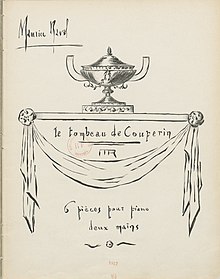Le Tombeau de Couperin

Le Tombeau de Couperin (The Grave of Couperin) is a suite for solo piano by Maurice Ravel, composed between 1914 and 1917. The piece is in six movements, based on those of a traditional Baroque suite. Each movement is dedicated to the memory of a friend of the composer (or in one case, two brothers) who had died fighting in World War I. Ravel also produced an orchestral version of the work in 1919, although this omitted two of the original movements.
Overview
[edit]The word tombeau in the title is a musical term popular from the 17th century, meaning "a piece written as a memorial". The specific Couperin, among a family noted as musicians for about two centuries, that Ravel intended to evoke is thought to be François Couperin "the Great" (1668–1733). Ravel stated that his intention was to pay homage more generally to the sensibilities of the Baroque French keyboard suite, not necessarily to imitate or pay tribute to Couperin himself in particular. This is reflected in the piece's structure, which imitates a Baroque dance suite.[1]
As a preparatory exercise, Ravel had transcribed a forlane (an Italian folk dance) from the fourth suite of Couperin's Concerts royaux, and this piece invokes Ravel's Forlane structurally. The other movements are similarly based on Baroque forms, with the Toccata taking the form of a perpetuum mobile reminiscent of Alessandro Scarlatti.[2] Ravel also revives Baroque practices through his distinctive use of ornamentation and modal harmony. Neoclassicism also shines through with Ravel's pointedly twentieth-century chromatic melody and piquant harmonies, particularly in the dissonant Forlane.
Written after the death of Ravel's mother in 1917 and of friends in the First World War, Le Tombeau de Couperin is a light-hearted, and sometimes reflective work rather than a sombre one which Ravel explained in response to criticism saying, "The dead are sad enough, in their eternal silence".[3]
The first performance of the original piano version was given on 11 April 1919 by Marguerite Long, in the Salle Gaveau in Paris. Long was the widow of Joseph de Marliave, to whom the last movement of the piece, the Toccata, is dedicated.[4]
Composition
[edit]The movements are as follows:
I
|
Prélude | Vif | 12
16 |
E minor[5] | in memory of First Lieutenant Jacques Charlot (transcriber of Ma mère l'oye for piano solo) | ||
II
|
Fugue | Allegro moderato | 4
4 |
E minor | in memory of Second Lieutenant Jean Cruppi (to whose mother, Louise Cruppi, Ravel had also dedicated L'heure espagnole) | ||
III
|
Forlane | Allegretto | 6
8 |
E minor | in memory of First Lieutenant Gabriel Deluc (a Basque painter from Saint-Jean-de-Luz) | ||
IV
|
Rigaudon | Assez vif | 2
4 |
C major | in memory of Pierre and Pascal Gaudin (two brothers and childhood friends of Ravel, killed by the same shell in November 1914) | ||
V
|
Menuet | Allegro moderato | 3
4 |
G major | in memory of Jean Dreyfus (at whose home Ravel recuperated after he was demobilized) | ||
VI
|
Toccata | Vif | 2
4 |
E minor ending in E major
|
in memory of Captain Joseph de Marliave (musicologist and husband of Marguerite Long) |
Orchestrations and transcriptions
[edit]
In 1919 Ravel orchestrated four movements of the work (Prélude, Forlane, Menuet and Rigaudon);[6] this version was premiered in February 1920 by Rhené-Baton and the Pasdeloup Orchestra, and has remained one of his more popular works.[citation needed] The orchestral version clarifies the harmonic language of the suite and brings sharpness to its classical dance rhythms. The oboe features prominently, taking the melody in the Prélude and the Menuet, as well as for the pastoral C minor section of the Rigaudon, where it is accompanied by guitar-like pizzicati.[7]
The orchestrated version is scored for two flutes (one doubling piccolo), two oboes (one doubling cor anglais), two clarinets, two bassoons, two horns, trumpet, harp, and strings.
Four movements (Prélude, Fugue, Menuet, and Rigaudon) have been arranged for wind quintet by American horn player Mason Jones (1919–2009).[8] Danish composer Hans Abrahamsen has also transcribed four movements for wind quintet,[9] and further, American composer Gunther Schuller has made a wind-quintet arrangement.[10]
References
[edit]- ^ Nancy Bricard, "About the Music", in Ravel: Le tombeau de Couperin (Van Nuys: Alfred Publishing, 2003), p. 9.
- ^ Nancy Bricard, "About the Music", in Ravel: Le tombeau de Couperin (Van Nuys: Alfred Publishing, 2003), p. 14.
- ^ Duban, Jeffrey (2016). The Lesbian Lyre. West Hoathly: Clairview. pp. 238–239. ISBN 9781905570805.
- ^ Nancy Bricard, "Foreword", in Ravel: Le Tombeau de Couperin (Van Nuys: Alfred Publishing, 2003), p. 1.
- ^ Chen Chih-Yi (May 2013). "Synthesis of Tradition and Innovation: A Study of Ravel's Le Tombeau de Couperin (Doctor of Music thesis)" (PDF). Indiana University. p. 15.
- ^ Arbie Orenstein (1991). Ravel: Man and Musician. New York: Dover Publications. p. 234. ISBN 9780486266336.
- ^ Gene Tyranny, Blue. "Le tombeau de Couperin, for orchestra". AllMusic.com. Retrieved 13 October 2012.
- ^ Maurice Ravel, Le Tombeau de Couperin, transcribed for wind quintet by Mason Jones (Paris: Ed. Durand, 1970).
- ^ Maurice Ravel, Le Tombeau de Couperin, arranged for wind quintet by Hans Abrahamsen (Copenhagen: Ed. Wilhelm Hansen, n.d.).
- ^ Maurice Ravel, Le Tombeau de Couperin, arranged for wind quintet by Gunther Schuller (Newton Centre, MA: Margun Music, 1995).
External links
[edit]- Le Tombeau de Couperin: Scores at the International Music Score Library Project
- Le Tombeau de Couperin - free complete recording at The Piano Society
- Listen to Toccata from Le Tombeau de Couperin orchestrated by Kenneth Hesketh
- Youtube: Orchestration of the Fugue and Toccata by Jack M. Jarrett (1982)
- Youtube: Jazz arrangement of the Prelude by Tamir Hendelman (piano), Marco Panascia (bass), Lewis Nash (drums) (2010)
